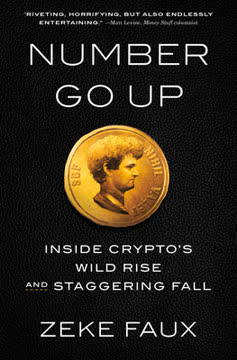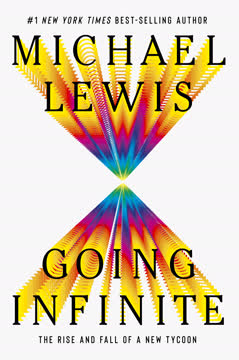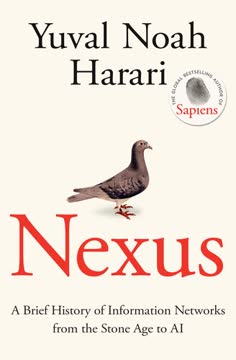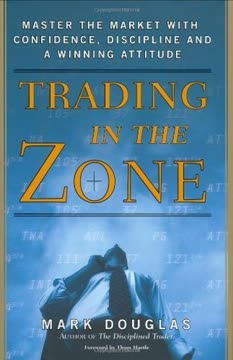Key Takeaways
1. DeFi's Rise: Challenging Traditional Finance
It will make the startling trillion-dollar rise of Bitcoin look pedestrian by comparison.
Disruptive potential. Decentralized Finance (DeFi) is poised to revolutionize the global financial system, potentially overshadowing even Bitcoin's meteoric rise. This new technology promises to disrupt established institutions and reshape how we interact with money.
Reactions from incumbents. Traditional financial institutions are taking notice, with CEOs of major banks acknowledging the "enormous competitive threat" from DeFi. This recognition signals a significant shift in the financial landscape.
Impact on individuals. DeFi aims to make financial services more accessible, fairer, and less expensive for everyone, regardless of their location or financial status. This includes easier access to loans, higher interest rates on deposits, and lower transaction fees.
2. Trustless Systems: The Core of DeFi
A trustless economic system means that participants need not trust anyone in that system.
Eliminating intermediaries. DeFi seeks to eliminate the need for intermediaries like banks by using mathematics and code to ensure immutability and security. This "trustless" approach reduces costs and increases transparency.
Decentralization in action. Decentralization distributes control across a network of computers, making it difficult for any single entity to manipulate the system. This consensus-based approach ensures that transactions are verified and validated by multiple parties.
Permissionless access. DeFi is permissionless, meaning anyone can participate without needing approval from a central authority. This open access fosters innovation and levels the playing field for individuals and businesses.
3. Ethereum and Smart Contracts: The Foundation of DeFi
The genius of the smart contract, imagined and implemented by the original Ethereum team, is that it is designed to merge human agreements (specifically financial agreements) into a formal computer language, made unambiguous and deterministic.
Programmable money. Ethereum's smart contracts allow developers to create decentralized applications (dApps) that automate financial agreements. These contracts are self-executing and transparent, reducing the need for intermediaries.
Turing-complete language. Ethereum's Solidity programming language is "Turing-complete," meaning it can solve any computational problem. This flexibility enables developers to build a wide range of financial applications on the Ethereum blockchain.
Smart contract advantages. Smart contracts offer several advantages over traditional contracts, including immutability, transparency, and automatic execution. This makes them ideal for automating financial agreements and reducing the risk of fraud.
4. Financial Institutions: DeFi's Primary Targets
A large slice of the TradFi industry will be shown up by DeFi as slow, inflexible, expensive, unfair, opaque and inefficient.
Vulnerabilities exposed. DeFi is targeting the inefficiencies and opacities of traditional financial institutions, offering faster, cheaper, and more transparent services. This includes deposits, loans, insurance, trading, and payments.
Trust as a commodity. Banks sell trust, but DeFi aims to provide trustless alternatives that eliminate the need for intermediaries. This challenges the traditional banking model and its reliance on fees and rent extraction.
Unequal treatment. Traditional financial institutions often treat customers differently based on their wealth, offering better rates and services to larger clients. DeFi aims to level the playing field by providing equal access to financial services for everyone.
5. Stablecoins: Bridging DeFi and TradFi
Most importantly, it would create a predictable and safe trading environment between banks and the cryptocurrency world, the final financial border between real and virtual.
Dollar-pegged cryptocurrencies. Stablecoins are cryptocurrencies designed to maintain a stable value, typically pegged to the US dollar. This stability makes them ideal for trading, lending, and other financial activities within the DeFi ecosystem.
Fiat-collateralized vs. crypto-collateralized. Stablecoins can be collateralized by fiat currencies like the US dollar or by other cryptocurrencies. DAI, for example, is a crypto-backed stablecoin that uses a system of vaults and stability fees to maintain its peg.
Increased velocity of currency. Stablecoins facilitate faster and more efficient transactions, increasing the velocity of money and potentially boosting economic activity. This has attracted the attention of central banks and policymakers.
6. Lending and Yield Farming: DeFi's Reinvention of Banking
How can a bank possibly compete against this? If you were the CEO of a financial institution, might you not be worried about your lunch being eaten?
Decentralized lending platforms. DeFi lending platforms like Compound and Aave allow users to borrow and lend cryptocurrencies without intermediaries. These platforms use smart contracts to automate the lending process and ensure transparency.
Liquidity pools and yield farming. Liquidity pools are pools of cryptocurrencies that are used to facilitate trading and lending. Yield farming involves providing liquidity to these pools in exchange for rewards, such as interest and governance tokens.
Incentivized participation. DeFi lending platforms incentivize participation by rewarding users with governance tokens and other benefits. This creates a more democratic and inclusive financial system.
7. Decentralized Exchanges (DEXs): Trading Without Intermediaries
The DeFi solution is called a DEX, a decentralised exchange.
Cutting out the middleman. Decentralized exchanges (DEXs) allow users to trade cryptocurrencies directly with each other, without the need for a central authority. This eliminates the fees and risks associated with traditional exchanges.
Automated Market Makers (AMMs). DEXs often use Automated Market Makers (AMMs) to provide liquidity and facilitate trading. AMMs use algorithms to determine the price of assets and match buyers and sellers.
Liquidity provider incentives. DEXs incentivize liquidity providers by rewarding them with a portion of the trading fees. This creates a more decentralized and efficient trading environment.
8. Oracles: Connecting DeFi to the Real World
Blockchains are blind to the real world.
Bridging the gap. Oracles are services that provide real-world data to smart contracts. This data can include prices, weather conditions, and other information that is needed to execute financial agreements.
Chainlink's role. Chainlink is a leading oracle provider that uses a decentralized network of nodes to ensure the accuracy and reliability of data. This helps to prevent manipulation and fraud.
Expanding smart contract capabilities. By connecting smart contracts to real-world data, oracles enable a wide range of new applications, including insurance, derivatives, and supply chain management.
9. NFTs: Beyond Digital Collectibles
It is a secure certification of ownership.
Unique digital assets. NFTs (Non-Fungible Tokens) are unique digital assets that represent ownership of a specific item, such as a work of art, a collectible, or a virtual item. NFTs are stored on a blockchain, making them secure and transparent.
Expanding use cases. While NFTs have gained popularity as digital collectibles, they have a wide range of potential applications, including real estate, supply chain management, and identity verification.
Fractional ownership. NFTs can be divided into smaller pieces, allowing for fractional ownership of high-value assets. This makes it easier for individuals to invest in art, real estate, and other assets that were previously inaccessible.
10. The Scalability Trilemma: DeFi's Biggest Challenge
He claimed that blockchains could not satisfy all three requirements equally.
Security, decentralization, scalability. The scalability trilemma states that blockchains cannot simultaneously achieve security, decentralization, and scalability. Improving one aspect often comes at the expense of another.
Layer 2 solutions. Layer 2 solutions are designed to improve the scalability of blockchains by processing transactions off-chain. These solutions can significantly increase the throughput of transactions while maintaining security and decentralization.
Ethereum 2.0. Ethereum 2.0 is a major upgrade to the Ethereum blockchain that aims to address the scalability trilemma. This upgrade includes sharding and Proof-of-Stake, which are designed to increase the network's throughput and energy efficiency.
11. Risks in DeFi: Navigating the Uncharted Waters
DeFi’s novelty, as well as the ease of transferring funds and creating complex instruments, may increase the possibility of abuses, whether by the creators of DeFi protocols, the operators of exchanges or third-party manipulators.
Smart contract bugs. Smart contract bugs can lead to significant financial losses, as demonstrated by the DAO hack and other incidents. Audits and formal verification methods are crucial for mitigating this risk.
Composability risks. The composability of DeFi protocols can create complex interdependencies that increase the risk of systemic failures. A bug in one protocol can have cascading effects on other protocols.
Regulatory uncertainty. The lack of clear regulatory guidelines creates uncertainty and risk for DeFi projects. Governments around the world are grappling with how to regulate this new industry.
12. Regulation and the Future of DeFi
The incumbents [banks] may throw sand in the wheels and the regulators may slow things, but it is simply a better financial technology because it provides real-time gross settlement without intermediaries, whereas the fiat system can only provide delayed net settlement with the assistance of many intermediaries.
Navigating the regulatory landscape. The future of DeFi will depend on how regulators choose to approach this new technology. Clear and well-defined regulations are needed to foster innovation and protect consumers.
Central bank digital currencies (CBDCs). Central banks are exploring the possibility of issuing their own digital currencies. CBDCs could potentially compete with stablecoins and other cryptocurrencies.
The future of finance. DeFi has the potential to transform the financial system, making it more accessible, efficient, and transparent. However, it also faces significant challenges, including scalability, security, and regulation.
Last updated:
Review Summary
Beyond Bitcoin receives mixed reviews, with ratings ranging from 2 to 5 stars. Some readers praise it as an excellent primer on DeFi, offering a concise overview of the crypto world. Others criticize it for lacking depth and being overly enthusiastic about blockchain technology. Critics argue that the book fails to address key questions about the feasibility and regulation of DeFi solutions. While some find it informative and well-written, others feel it oversimplifies complex topics and may quickly become outdated due to the rapidly evolving nature of the crypto space.
Similar Books










Download PDF
Download EPUB
.epub digital book format is ideal for reading ebooks on phones, tablets, and e-readers.




